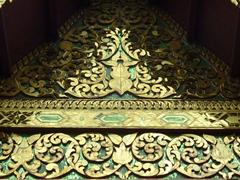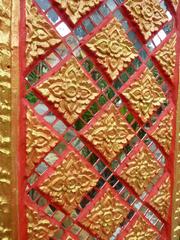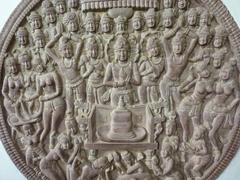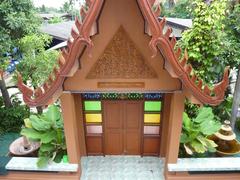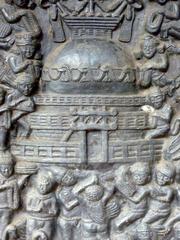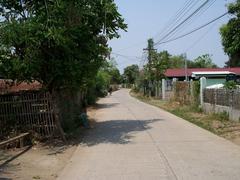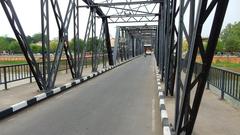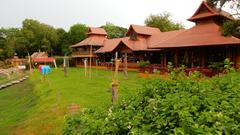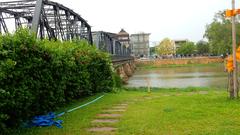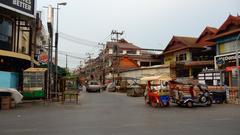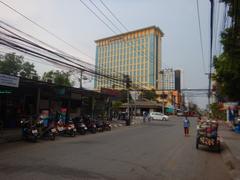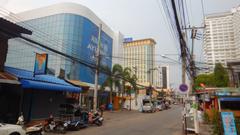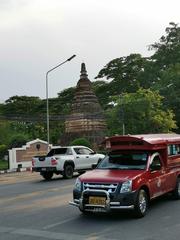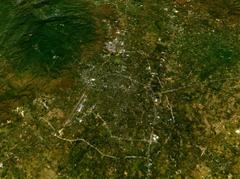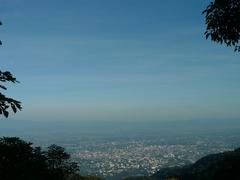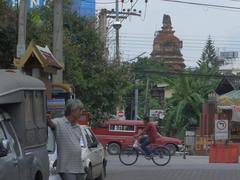
A Witty Local’s Guide to Discovering Chiang Mai, Thailand
When to Go: 13/08/2024
Welcome to Chiang Mai: A Journey Begins
Welcome to Chiang Mai, the enchanting ‘Rose of the North,’ where ancient traditions blend seamlessly with modern vibrancy. Imagine wandering through a city where every street corner whispers tales of a bygone era, and every temple stands as a testament to its rich cultural heritage. Founded in 1296 by King Mengrai, Chiang Mai was born under auspicious signs, strategically nestled along the Ping River, a vital tributary for trade and communication. The city served as the capital of the Lanna Kingdom, a cultural powerhouse that spanned northern Thailand, Laos, Myanmar, and even parts of China (Wikipedia). Chiang Mai’s history is a captivating saga of resilience, from its Burmese occupation and subsequent liberation, to its integration into modern-day Thailand in the late 18th century (Chiang Mai History). Today, Chiang Mai is a vibrant cultural hub, renowned for its festivals, traditional handicrafts, and architectural marvels. Whether you’re exploring ancient temples like Wat Phra Singh and Wat Chedi Luang, or participating in the mesmerizing Yi Peng Lantern Festival, Chiang Mai promises an unforgettable journey through time and culture (Britannica).
Explore the Chapters
- Discovering Chiang Mai: A Journey Through Time and Culture
- A City Born from Legends
- The Lanna Kingdom: A Cultural Powerhouse
- Burmese Occupation and Siamese Influence: Tug of War
- A New Dawn: Integration into Siam
- Architectural Marvels and Spiritual Sanctuaries
- From Past to Present: Modern Developments
- A Cultural Hub: Festivals and Handicrafts
- Insider Tips for the Adventurous Traveler
- Cultural Significance of Chiang Mai
- A Journey Through Time
- Historical Context
- Architectural Heritage
- Temples and Religious Sites
- Tha Phae Gate
- Festivals and Events
- Markets and Artisan Villages
- Culinary Traditions
- Practical Tips and Local Secrets
- Day Trips and Excursions
- Top Attractions in Chiang Mai, Thailand
- Temples and Traditions
- Markets and Munchies
- Natural Wonders
- Festivals and Fun
- Hidden Gems and Quirky Spots
- Local Tips and Tricks
Discovering Chiang Mai: A Journey Through Time and Culture
A City Born from Legends
Picture this: a city nestled among lush mountains, born under auspicious signs like herds of spotted deer and a giant fig tree. Welcome to Chiang Mai, which translates to ‘new city’ in Thai. Founded in 1296 by King Mengrai, this ‘Kingdom of a Million Rice Fields’ was strategically placed along the Ping River, a vital tributary for trade and communication. Intrigued yet? (Wikipedia) (The Not So Innocents Abroad).
The Lanna Kingdom: A Cultural Powerhouse
Imagine a kingdom so fertile and rich in culture that it sprawled across what is now northern Thailand, Laos, Myanmar, and even China. The Lanna Kingdom was just that. Despite being a target for invasions, its cultural heritage flourished, making it a true gem of its time (Chiang Mai History).
Burmese Occupation and Siamese Influence: Tug of War
Ever felt like the prized possession in a tug-of-war? Chiang Mai did. Conquered by the Burmese in 1557, it became a vassal state but never lost its Siamese (Thai) influence. The city managed to shake off Burmese control with the help of Siamese King Taksin in 1774, only to be abandoned temporarily due to counterattacks. Talk about resilience! (Chiang Mai History) (Wikipedia).
A New Dawn: Integration into Siam
Chiang Mai’s revival began in the late 18th century under Prince Kawila, who resettled and rebuilt the city. He restored historic buildings and temples, eventually establishing the Chuea Chet Ton Dynasty. By 1892, Chiang Mai was fully integrated into Siam, becoming a province in 1932 and contributing to the formation of modern-day Thailand (The Not So Innocents Abroad) (Chiang Mai History).
Architectural Marvels and Spiritual Sanctuaries
Stroll through Chiang Mai, and you’ll encounter ancient temples and fortresses that tell tales of old. The Old City Walls and the moat surrounding the square-shaped Old City are like whispers from the past. Temples like Wat Phra Singh and Wat Chedi Luang stand as spiritual and architectural landmarks, each with stories of their own (The Bush Camp Chiang Mai) (The Not So Innocents Abroad).
From Past to Present: Modern Developments
Chiang Mai has evolved significantly since its establishment as a sanitary district in 1915. Today, it’s divided into four vibrant electoral wards: Nakhon Ping, Sriwichai, Mengrai, and Kawila. Each offers a unique slice of the city’s character (Wikipedia).
A Cultural Hub: Festivals and Handicrafts
Think of Chiang Mai as the heartbeat of northern Thailand, a hub for traditional Thai handicrafts like silverwork, wood carving, and pottery. Its festivals, such as the Yi Peng Lantern Festival and the Songkran Water Festival, draw tourists from all corners of the globe, adding a vibrant touch to the city’s cultural tapestry (Britannica).
Insider Tips for the Adventurous Traveler
Ready to explore? The best time to visit Chiang Mai is between October and April when the weather is just right. Dive into local cuisine with a food tour, or hunt for unique souvenirs at the famous Night Bazaar. For those seeking adventure, trekking in the lush mountains is a must (Nomadic Matt).
In summary, Chiang Mai is not just a city; it’s an experience that blends rich history, cultural heritage, and modern charm. Whether you’re wandering through ancient temples, participating in vibrant festivals, or simply soaking in the local atmosphere, Chiang Mai promises a journey you’ll never forget.
Cultural Significance of Chiang Mai
A Journey Through Time
Welcome to Chiang Mai, a city where the past and present dance together in a symphony of culture and history. Imagine walking through ancient streets where legends come alive, and every corner holds a story waiting to be discovered.
Historical Context
Chiang Mai, founded in 1296 by King Mengrai, served as the capital of the Lanna Kingdom. The city’s name, meaning “new city,” reflects its importance as a cultural and political hub. One captivating legend tells of the White Elephant carrying a relic of the Buddha to Doi Suthep’s summit, where it was enshrined at Wat Phra That Doi Suthep.
Architectural Heritage
Chiang Mai’s unique Lanna-style architecture, with intricate wood carvings and tiered rooftops, is a visual feast. Dive into the city’s architectural splendor at the Chiang Mai Historical Center, where artifacts and interactive displays bring the Lanna traditions to life.
Temples and Religious Sites
Chiang Mai is home to over 300 temples, each steeped in history and cultural significance. Key temples include:
- Wat Phra That Doi Suthep: Perched on Doi Suthep mountain, this sacred site offers panoramic city views and is a pilgrimage destination for many Buddhists.
- Wat Chedi Luang: Known for its massive chedi (stupa), partially destroyed by a 16th-century earthquake, and the city pillar and a replica of the Emerald Buddha.
- Wat Phra Singh: Renowned for its Lanna-style architecture and the revered Phra Singh Buddha image.
Tha Phae Gate
Built during King Mengrai’s 13th-century reign, Tha Phae Gate symbolizes Chiang Mai’s rich history and vibrant present. Despite several renovations, it retains its charming architectural essence. Today, it’s a bustling meeting point where locals and tourists explore the city’s lively street life and cultural offerings (Tha Phae Gate).
Festivals and Events
Chiang Mai’s festivals reflect its rich cultural heritage:
- Yi Peng (Lantern Festival): In November, thousands of lanterns are released into the sky, symbolizing the release of misfortunes and the welcoming of good luck.
- Songkran (Thai New Year): In April, water fights, parades, and traditional rituals pay respect to elders and monks.
- Loi Krathong: Celebrated alongside Yi Peng, involving floating decorated baskets (krathongs) on water bodies to honor the river goddess and seek forgiveness for past misdeeds.
Markets and Artisan Villages
Chiang Mai’s vibrant markets and artisan villages offer glimpses into its cultural and economic life:
- Sunday Walking Street Market: At Tha Phae Gate, this market is a lively scene of local handicrafts, live music, and delicious street food (Sunday Walking Street Market).
- Night Bazaar: A city center market offering clothing, accessories, local crafts, and souvenirs.
- Baan Tawai Village: A hub for traditional Lanna art and craftsmanship, known for its woodcarving and handicrafts.
Culinary Traditions
Chiang Mai’s cuisine is a delightful fusion of flavors and textures. Must-try dishes include:
- Khao Soi: Coconut curry noodle soup topped with crispy noodles and served with pickled mustard greens, shallots, and lime.
- Sai Ua (Northern Thai Sausage): Spicy sausage made with minced pork, herbs, and spices.
- Nam Prik Ong: Chili dip made with minced pork, tomatoes, and spices, typically served with fresh vegetables.
For a unique dining experience, visit the Night Bazaar and sample a variety of street food options.
Practical Tips and Local Secrets
When planning your visit to Chiang Mai, consider these tips from a local’s perspective:
- Best Time to Visit: November to February is ideal, with cool, dry weather. Avoid March to May due to hot weather and poor air quality during the burning season (Global Gallivanting).
- Getting Around: Explore the city by tuk-tuk, taxi, or rented motorbike for flexibility.
- Accommodation: From budget guesthouses to luxury hotels, the Old City is a popular area due to its proximity to major attractions.
- Cultural Etiquette: Dress modestly when visiting temples, covering shoulders and knees. Remove your shoes before entering temple buildings and be respectful of religious practices.
- Hidden Gems: Discover lesser-known spots like the hidden murals in small alleys or a quaint coffee shop tucked away in a serene corner of the city.
Day Trips and Excursions
Chiang Mai is a great base for exploring the region. Recommended day trips include:
- Chiang Rai: Visit the stunning White Temple (Wat Rong Khun) and the Golden Triangle, where Thailand, Laos, and Myanmar converge (Global Gallivanting).
- Doi Inthanon National Park: Explore Thailand’s highest peak, waterfalls, and hill tribe villages.
- Elephant Sanctuaries: Learn about conservation efforts and the importance of protecting these magnificent creatures (Agoda).
Conclusion
Chiang Mai’s rich cultural heritage, vibrant festivals, and diverse attractions make it a must-visit destination for travelers seeking an immersive experience in Northern Thailand. Whether you’re exploring ancient temples, sampling local cuisine, or participating in traditional festivals, Chiang Mai offers a unique blend of history, culture, and adventure. Don’t forget to bring the Audiala app along for an enhanced exploration experience!
Discover the Magic of Chiang Mai: A Whimsical Guide to the Rose of the North 🌹
Introduction
Welcome to Chiang Mai, Thailand’s enchanting northern gem where ancient temples meet modern cafes, and bustling markets hum with the spirit of tradition. Picture yourself wandering through a city where the past whispers from temple walls and every street corner bursts with life. Ready for an adventure? Let’s dive into the best of Chiang Mai, seasoned with local secrets and a dash of humor.
Temples and Traditions
Wat Phra That Doi Suthep: The Jewel in the Sky
Imagine climbing 306 steps, each guarded by mythical Naga serpents, to a golden chedi that glows like a beacon over Chiang Mai. Wat Phra That Doi Suthep isn’t just a temple; it’s a rite of passage. Founded in 1383, this sacred site offers panoramic views that will make your Instagram followers green with envy. Pro tip: Visit at dusk for a magical blend of twilight and temple lights (Nomadasaurus).
Wat Chedi Luang: The Giant’s Ruin
Once towering at 82 meters, Wat Chedi Luang’s massive chedi was partially toppled by an earthquake in the 16th century. But don’t let that fool you—this temple remains a giant in spiritual significance. Stroll through its serene grounds, and don’t miss the City Pillar and the replica of the Emerald Buddha (Nomadasaurus).
Wat Umong: The Tunnel Temple
Hidden in a forest on Chiang Mai’s outskirts, Wat Umong’s ancient tunnels and serene lake offer a peaceful retreat. Perfect for meditation or a quiet afternoon, this temple feels like a secret garden waiting to be discovered (The Broke Backpacker).
Markets and Munchies
Chiang Mai Night Bazaar: The Shopper’s Paradise
Every evening, Chang Klan Road transforms into a bustling market. From handicrafts to street food, the Chiang Mai Night Bazaar is a sensory overload. Whether you’re hunting for souvenirs or just soaking in the vibrant atmosphere, this market is a must-see (Moments Log).
Sunday Walking Street Market: The Weekend Carnival
On Sunday evenings, Ratchadamnoen Road morphs into a lively walking street market. It’s a treasure trove of handmade crafts, clothing, and delectable street food. Don’t miss the street performers—it’s like a mini-festival every week! (Nomadasaurus).
Chiang Mai Gate Night Market: A Foodie’s Delight
Located near the southern gate of the Old City, this night market is a culinary adventure. From Khao Soi to Sai Oua, indulge in northern Thai specialties that will tantalize your taste buds (Lonely Planet).
Natural Wonders
Doi Inthanon National Park: The Roof of Thailand
Home to Thailand’s highest peak, Doi Inthanon National Park is a paradise for nature lovers. With lush forests, cascading waterfalls, and scenic viewpoints, it’s perfect for hiking and bird-watching. Don’t miss the twin pagodas and the local hill tribe culture (Barefoot Caribou).
Bua Thong Sticky Waterfalls: Nature’s Playground
Climb up and down the cascades of Bua Thong Waterfalls, where the limestone rocks provide a surprisingly non-slippery grip. It’s a fun, unique experience that feels like nature’s very own playground (Let’s Venture Out).
Huay Tung Tao Reservoir: The Urban Escape
Just a short drive from the city, Huay Tung Tao Reservoir offers a serene escape with picturesque views, bamboo huts for picnicking, and activities like swimming and paddle boating. It’s the perfect spot to unwind (Barefoot Caribou).
Festivals and Fun
Loy Krathong and Yi Peng: The Festival of Lights
In November, Chiang Mai lights up with the majestic Loy Krathong and Yi Peng festivals. Release decorated floats into the water and lanterns into the sky in a captivating spectacle. Key locations include the Ping River, Tha Pae Gate, and the Three Kings Monument (Asia Highlights).
Chiang Mai Flower Festival: A Blooming Celebration
Every February, Suan Buak Haad City Park bursts into color for the Chiang Mai Flower Festival. With elaborate floral displays, parades, and competitions, this festival is a feast for the eyes and a celebration of the region’s horticultural beauty (Lonely Planet).
Hidden Gems and Quirky Spots
Nimman Area: The Hipster Haven
Nimmanhaemin Road, or Nimman, is Chiang Mai’s trendiest district. With hip cafes, boutique shops, and a vibrant nightlife, it’s a modern contrast to the historic Old City. Perfect for digital nomads and young travelers looking for a blend of culture and cool (CK Travels).
Wat Phan Tao: The Wooden Wonder
Near Wat Chedi Luang, Wat Phan Tao is a lesser-known gem with intricate teakwood architecture and a serene atmosphere. It’s a peaceful retreat in the heart of the city, perfect for those seeking a quieter temple experience (The Broke Backpacker).
Art in Paradise: The Interactive 3D Museum
Step into the world of optical illusions at Art in Paradise, where 3D paintings make you part of the artwork. It’s a fun, engaging experience for visitors of all ages, and a great spot for creative photos (Nomadasaurus).
Local Tips and Tricks
Cultural Etiquette: Do’s and Don’ts
- Respect the Monks: Always offer a wai (traditional greeting) and avoid touching them.
- Dress Modestly: Especially when visiting temples. Shoulders and knees should be covered.
- Shoes Off: Remove your shoes before entering homes and temples.
Local Lingo
- Sawasdee (ka/krub): Hello (female/male)
- Khop Khun (ka/krub): Thank you (female/male)
- Sabai Sabai: Relax, take it easy
Conclusion
Chiang Mai is more than a destination; it’s an experience waiting to be unlocked. From its historic temples to its vibrant markets and serene natural spots, this city has something for every traveler. Download Audiala to uncover even more secrets and stories as you explore the Rose of the North. Ready to embark on your Chiang Mai adventure? The magic awaits!
Your Chiang Mai Adventure Awaits
Chiang Mai is not merely a destination; it’s an immersive experience that invites you to delve into its rich history, vibrant culture, and stunning natural beauty. From the architectural splendor of its temples to the lively atmosphere of its markets, Chiang Mai offers a unique blend of the past and present. The city’s festivals, such as the Yi Peng Lantern Festival and Songkran, provide a glimpse into its cultural heartbeat, while its culinary delights like Khao Soi and Sai Ua tantalize the taste buds (Nomadic Matt). Beyond the obvious attractions, Chiang Mai’s hidden gems and quirky spots, like Wat Umong and the Bua Thong Sticky Waterfalls, offer unique experiences that are sure to leave a lasting impression. As you explore this enchanting city, remember to embrace its customs and traditions, from dressing modestly at temples to greeting locals with a respectful wai (Global Gallivanting). Ready to uncover the secrets of Chiang Mai? Download the Audiala app to enhance your journey with expertly crafted audio guides, providing deep insights and uncovering hidden gems that make Chiang Mai truly magical.
Sources and Links
- Wikipedia. Chiang Mai. Retrieved from https://en.wikipedia.org/wiki/Chiang_Mai
- The Not So Innocents Abroad. A Brief History of Chiang Mai. Retrieved from https://www.thenotsoinnocentsabroad.com/blog/a-brief-history-of-chiang-mai
- Chiangmai.net. History of Chiang Mai. Retrieved from https://www.chiangmai.net/history
- The Bush Camp Chiang Mai. Historical Landmarks of Chiang Mai. Retrieved from https://thebushcampchiangmai.com/historical-landmarks-of-chiang-mai/
- Britannica. Chiang Mai. Retrieved from https://www.britannica.com/place/Chiang-Mai
- Nomadic Matt. Chiang Mai Travel Tips. Retrieved from https://www.nomadicmatt.com/travel-guides/thailand-travel-tips/chiang-mai/
- Agoda. Unveiling Chiang Mai: A Complete Traveler’s Guide to the City’s Best Attractions. Retrieved from https://www.agoda.com/travel-guides/thailand/chiang-mai/unveiling-chiang-mai-a-complete-travelers-guide-to-the-citys-best-attractions/
- Thailand Nomads. Chiang Mai Historical Center. Retrieved from https://www.thailandnomads.com/historical-center-chiang-mai/
- ThailandTV. Tha Phae Gate: Where Chiang Mai’s History Meets Modern Charm. Retrieved from https://thailandtv.tv/tha-phae-gate-where-chiang-mais-history-meets-modern-charm-thailand/
- Global Gallivanting. Chiang Mai Itinerary. Retrieved from https://www.global-gallivanting.com/chiang-mai-itinerary/
- Momadsaurus. 10 Things to Do in Chiang Mai. Retrieved from https://www.nomadasaurus.com/10-things-to-do-in-chiang-mai/
- The Broke Backpacker. Chiang Mai Itinerary. Retrieved from https://www.thebrokebackpacker.com/chiang-mai-itinerary/
- Moments Log. The Vibrant Markets of Thailand’s Chiang Mai: Cultural Experiences. Retrieved from https://www.momentslog.com/travel/the-vibrant-markets-of-thailands-chiang-mai-cultural-experiences
- Lonely Planet. Things to Know Before Traveling to Chiang Mai. Retrieved from https://www.lonelyplanet.com/articles/things-to-know-before-traveling-to-chiang-mai
- Barefoot Caribou. Things to Do in Chiang Mai. Retrieved from https://barefootcaribou.com/things-to-do-in-chiang-mai/
- Let’s Venture Out. Chiang Mai Itinerary. Retrieved from https://www.letsventureout.com/chiang-mai-itinerary/
- Asia Highlights. Loy Krathong Festival in Chiang Mai. Retrieved from https://www.asiahighlights.com/thailand/loy-krathong-festival/chiang-mai
- CK Travels. Chiang Mai: Things to Do. Retrieved from https://www.cktravels.com/chiang-mai-things-to-do/
